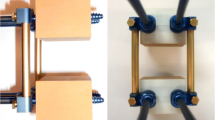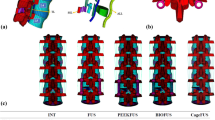Abstract
Posterior spinal instrumentation is frequently used for the treatment of spine disorders. Importantly, different requirements have to be considered for the optimal use of these systems in various clinical scenarios. In this work, we focused on the role of rods diameter on hardware’s stiffness. For this purpose, we established an in vitro model and compared the response to axial load of a posterior stabilization system, characterized by rods of different diameter (4, 5, 6 mm), with that of Dynesys®. Intuitively, the higher the stiffness of the hardware, the lower the load is transferred to the disc. However, the 4 hardware tested showed a different trend in the response to the load regimens: when increasing the load, more flexible systems display a progressive reduction in the percentage of load which is transferred to the disc while more rigid system display the opposite trend. Considering that the load which is transferred, and not by-passed by the hardware, influences the healing of a fracture; the integration of a bone graft or a cage; the fusion process, these data have a relevant impact on clinical practice and highlight features that have to be considered in the choice for the optimal posterior spinal instrumentation.




Similar content being viewed by others
References
Hanley EN (1995) The indications for lumbar spinal fusion with and without instrumentation. Spine (Phila Pa 1976) 20(24 Suppl):143S–153S
Sonntag VK, Marciano FF (1995) Is fusion indicated for lumbar spinal disorders? Spine (Phila Pa 1976) 20(24 Suppl):138S–142S
Fritzell P, Hägg O, Wessberg P, Nordwall A, Swedish Lumbar Spine Study Group (2001) 2001 Volvo Award Winner in Clinical Studies: Lumbar fusion versus nonsurgical treatment for chronic low back pain: a multicenter randomized controlled trial from the Swedish Lumbar Spine Study Group. Spine (Phila Pa 1976) 26(23):2521–2532 (discussion 2532–2534)
Park WM, Park YS, Kim K, Kim YH (2009) Biomechanical comparison of instrumentation techniques in treatment of toracolumbar burst fractures: a finite element analysis. J Orthop Sci 14(4):443–449
Brown T, Hansen RJ, Yorra AJ (1957) Some mechanical tests on the lumbosacral spine with particular reference to the intervertebral discs; a preliminary report. J Bone Joint Surg Am 39-A(5):1135–1164
Cripton PA, Jain GM, Wittenberg RH, Nolte LP (2000) Load-sharing characteristics of stabilized lumbar spine segments. Spine (Phila Pa 1976) 25(2):170–179
Wilke HJ, Neef P, Caimi M, Hoogland T, Claes LE (1999) New in vivo measurements of pressures in the intervertebral disc in daily life. Spine (Phila Pa 1976) 24(8):755–762
Wolf A, Shoham M, Michael S, Moshe R (2001) Morphometric study of the human lumbar spine for operation-workspace specifications. Spine (Phila Pa 1976) 26(22):2472–2477
Mikles MR, Stchur RP, Graziano GP (2004) Posterior instrumentation for thoracolumbar fractures. J Am Acad Orthop Surg 12(6):424–435
Parker JW, Lane JR, Karaikovic EE, Gaines RW (2000) Successful short-segment instrumentation and fusion for thoracolumbar spine fractures: a consecutive 41/2-year series. Spine (Phila Pa 1976) 25(9):1157–1170
Harms J, Stoltze D (1992) The indications and principles of correction of post traumatic deformities. Eur Spine J 1(3):142–151
Hu SS (1997) Internal fixation in the osteoporotic spine. Spine (Phila Pa 1976) 22(24 Suppl):43S–48S
Stoll TM, Dubois G, Schwarzenbach O (2002) The dynamic neutralization system for the spine: a multi-center study of a novel non-fusion system. Eur Spine J 11(2 Suppl):S170–S178
Buckwalter JA, Mow VC, Boden SD, Eyre DR, Weidenbaum M (1999) Intervertebral disk structure, composition, and mechanical function. In: Buckwalter JA, Einhorn TA, Simon SR (eds) Orthopaedic Basic Science, 2nd edn. AAOS, USA, pp 551–555
Conflict of interest
None.
Author information
Authors and Affiliations
Corresponding author
Rights and permissions
About this article
Cite this article
Gioia, G., Scotti, C., Mandelli, D. et al. Posterior spinal instrumentation: biomechanical study on the role of rods on hardware response to axial load. Eur Spine J 20 (Suppl 1), 3–7 (2011). https://doi.org/10.1007/s00586-011-1746-1
Received:
Published:
Issue Date:
DOI: https://doi.org/10.1007/s00586-011-1746-1




